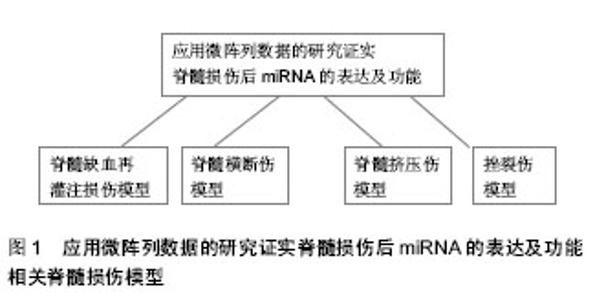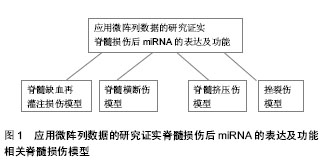Chinese Journal of Tissue Engineering Research ›› 2015, Vol. 19 ›› Issue (2): 267-272.doi: 10.3969/j.issn.2095-4344.2015.02.020
Previous Articles Next Articles
Spinal cord injury and MicroRNA: in vitro prefabrication of tissue-engineered spinal cord and repair of spinal cord injury
Li Mi, Yao Meng
- Department of Spinal Surgery, the Second Affiliated Hospital of Harbin Medical University, Harbin 150081, Heilongjiang Province, China
-
Received:2014-12-15Online:2015-01-08Published:2015-01-08 -
Contact:Yao Meng, Chief physician, Professor, Doctoral supervisor, Department of Spinal Surgery, the Second Affiliated Hospital of Harbin Medical University, Harbin 150081, Heilongjiang Province, China -
About author:Li Mi, Studying for master’s degree, Department of Spinal Surgery, the Second Affiliated Hospital of Harbin Medical University, Harbin 150081, Heilongjiang Province, China -
Supported by:the National Natural Science Foundation of China, No. 30770543
CLC Number:
Cite this article
Li Mi, Yao Meng. Spinal cord injury and MicroRNA: in vitro prefabrication of tissue-engineered spinal cord and repair of spinal cord injury[J]. Chinese Journal of Tissue Engineering Research, 2015, 19(2): 267-272.
share this article

2 文献证据综合提炼 2.1 纳入资料基本概况 纳入的文献包括脊髓损伤病理生理性概述性文章10篇[1-10],脊髓损伤后基因表达的改变类文章4篇[11-14],miRNA参与基因表达调控类文章17篇[15-31]。以此为依据对miRNA应用于未来脊髓损伤治疗的设想和展望的归纳和总结7篇[32-38]。 2.2 纳入资料的研究结果特征 2.2.1 脊髓损伤的病理生理概述 所谓脊髓损伤是指由于脊髓创伤或疾病引起的脊髓损害,伤者损伤后面临的功能缺陷很大程度上取决于其产生的生理应答反应。虽然大多数的脊髓损伤是由创伤引起的,这种打击的原因多为交通事故或暴力因素引起的机械损伤,但仍有部分脊髓损伤的患者是由于非创伤性因素所致,如椎间盘退变和肿瘤等原因。脊髓损伤初期至其后几个月内引发一些列复杂的病理生理学反应机制过程,从而影响神经、血管和免疫系统。脊髓损伤参与细胞大多源于脊髓,仍有部分细胞依靠循环系统运至损伤区域[6-6]。 创伤性脊髓损伤中,机械性创伤可导致脊髓的挤压、拉伸、撕裂或横断损伤。多数脊髓损伤损伤形式为挤压-挫裂型损伤,破裂的脊柱组织对脊髓产生瞬时或持久的挤压伤。挤压挫裂伤一旦达到结构阈值,即可引起一系列局部及全身细胞的生理生化反应,此过程为脊髓损伤的主要原因。局部损伤包括轴突断裂,神经元、神经胶质细胞和血管内皮细胞膜破裂甚至坏死。因细胞膜破裂产生的离子转移与释放,引起损伤区域尚存活的神经元细胞产生动作电位。由此产生的离子浓度达到中毒状态,引起周围的神经元坏死。兴奋性中毒引发的动作电位的导致神经递质释放与积累,会进一步加重神经元和神经胶质细胞的坏死[7]。表皮血管痉挛和血栓形成所造成缺氧,缺血,加速了神经细胞坏死。在机体层面,原发损伤引起一过性高血压之后随之而来长期低灌注压状态进一步加重脊髓缺氧。缺氧连同神经细胞内外离子的转移,引起损伤平面以下脊髓功能短暂性缺失,我们称之为脊髓休克[8]。 机械损伤后最初几分钟至数月为脊髓二次损伤的主要时期。此阶段损伤区主要破坏为血管变性,生物化学功能紊乱及细胞应答反应介导的炎性反应和细胞坏死,其中主要致炎因子如一氧化氮、白细胞介素1β、肿瘤坏死因子α、活性氧簇(reactive oxygen species,ROS)、细胞黏附分子(cell adhesion molecules,CAMs)[9]等。脊髓损伤病理生理学过程中免疫细胞的应答反应起到了关键作用,中性粒细胞的数量在损伤24 h后达到顶峰。中性粒细胞释放的信号蛋白引起巨噬细胞的聚集并在1周内达到顶峰且存在数月之久,进而导致表型细胞形态和功能上的变化[10]。T淋巴细胞为脊髓损伤后细胞介导的应答反应,其在损伤1周后进入损伤区域,但其在损伤区域的作用目前仍不明确。 脊髓损伤数月至1年后,脊髓损伤转归为慢性过程。细胞坏死、瘢痕化、神经胶质细胞增生以及局部组织变化所形成的胶质瘢痕累及损伤区及临近节段。功能离子通道内髓磷脂的丢失及变性引起神经元和轴突网状系统的变化进而导致慢性神经源性疼痛或痉挛。 2.2.2 脊髓损伤后基因表达的改变 大多数细胞的功能、应答反应及表型变化依赖于大量转录机制的激活或抑制。通过微阵列分析观察研究不同脊髓损伤模型的菌落或物种发现了基因表达的改变。这些基因表达的改变引起一系列表达的改变:①转录和应激反应,损伤24 h内引起大量凝集因子聚集如核因子κB(bnuclear factor kappa B,NF-κB)、热休克蛋白70(heat shock protein 70,HSP-70)、人干扰素调节因子1(interferon regulatory factors,IRF-1) 等。其中核因子κB和人干扰素调节因子1为细胞凋亡、再生及促炎症反应过程中的重要的转录激活因子。②炎症反应,脊髓损伤后初期,大量促炎症基因表达于损伤后14天恢复正常水平,其中主要的炎症介质为COX-2,白细胞介素1β、白细胞介素6和肿瘤坏死因子α等,其主要作用为调节免疫应答和细胞增值[11]。③神经元相关基因,大量塑形与再生相关蛋白(如Rab13,cAMP,Coronin 1b等)参与Na,K,Ca离子通道蛋白的的编码从而影响神经递质传递的兴奋偶联[12]。④细胞周期和细胞坏死,细胞周期基因的表达在损伤24 h后开始上调,如c-myc,pcdna,gadd45a及细胞周期蛋白等,"

| [1] 汪红林,徐祝军.脊髓损伤后细胞凋亡基因调控研究进展[J].国际骨科杂志, 2010,31(3):187-189. [2] Di Giovanni S, Knoblach SM. Gene profiling in spinal cord injury shows role of cell cycle in neuronal death. Ann Neurol. 2003;53(4):454-468. [3] Lee BB, Cripps RA, Fitzharris M, et al. The global map for traumatic spinal cord injury epidemiology:update,global incidencerate. Spinal Cord. 2012;158:110-116. [4] Liu NK, Wang XF, Lu QB, et al. Altered microRNA expression following traumatic spinal cord injury. Exp Neurol. 2009;219: 424-429. [5] De Biase A, Knoblach SM, Di Giovanni S, et al. Gene expression profiling of experimental traumatic spinal cord injury as a function of distance from impact site and injury severity. Physiol Genomics. 2005;22:368-381. [6] Strickland ER, Hook MA, Balaraman S, et al. MicroRNA dysregulation following spinal cord contusion: implications for neural plasticity and repair. Neuroscience. 2011;186:146-l60. [7] Mautes AE, Weinzierl MR, DonovanF, et al. Vascularevents after spinal cord injury: contribution to secondary pathogenesis. Phys Ther. 2000;80:673-687. [8] James W. Grau J, Huie R, et al. Metaplasticity and behavior: how training and inflammation affect plastic potential within the spinal cord and recovery after injury Front Neural Circuits. 2014;8:100. [9] Liu G, Keeler BE, Zhukareva V, et al. Cycling exercise affects the expression of apoptosis associated microRNAs after spinal cord injury in rats. Exp Neurol. 2010;226: 200-206. [10] Dale-Nagle EA, Hoffman MS, MacFarlane PM, et al. Spinal plasticity following intermittent hypoxia: implications for spinal injury. Ann N Y Acad Sci USA. 2010;1198:252-259. [11] Song G, Cechvala C, Resnick D, et al. Gene Chip analysis after acute spinal cord injury in rat. J Neurochem. 2001;79: 804-815. [12] Ambros V. microRNAs: tiny regulators with great potential. Cell. 2001;107:823-826. [13] Mendell LM, Munson JB, Arvanian VL. Neurotrophins and synaptic plasticity in the mammalian spinal cord. J Physiol. 2001;533:91-97. [14] Aimone JB, Leasure JL, Perreau VM, et al. Spatial and temporal gene expression profiling of the cont used rat spinal cord. Exp Neurol. 2004;189:204-221. [15] 汪进业,蔡荣,罗本燕.MicroRNA与神经系统重大疾病[J].生物化学与生物物理进展,2009;(1):29-32. [16] Cao X, Pfaff SL, Gage FH. A functional study of miR-124 in the developing neural tube. Genes Dev. 2007;21:531-536. [17] Scheff SW, Rabchevsky AG, Fugaccia I, et al. Experimental modeling of spinal cord injury: characterization of a forcedefined injury device. J Neurotrauma. 2003;20:179-193. [18] Liu G, Detloff MR, Miller KN, et al. Exercise modulates microRNAs that affect the PTEN/mTOR pathway in rats after spinal cord injury. Exp Neurol. 2012;233:447-456. [19] Bilen J, Liu N, Burnett BG, et al. MicroRNA pathways modulate polyglutamine-induced neurodegeneration. Mol Cell. 24:2006:157-163. [20] Cimmino A, Calin GA, Fabbri M et al.Croce CM. miR-15 and miR-16 induce apoptosis by targeting BCL2. Proc Natl Acad Sci U S A. 2005;102:13944-13949. [21] Vasudevan S, Tong Y, Steitz JA. Switching from repression to activation: microRNAs can up-regulate translation. Science. 2007;318:1931-1934. [22] Citron BA, Arnold PM, Haynes NG, et al. Neuroprotective effects of caspase-3 inhibition on functional recovery and tissue sparing after acute spinal cord injury. Spine. 2008;33: 2269-2277. [23] Moriyama T, Ohuchida K, Mizumoto K, et al. MicroRNA-21 modulates biological functions of pancreatic cancer cells including their proliferation, invasion, and chemoresistance. Mol Cancer Ther. 2009;8:1067-1074. [24] Ponomarev ED, Veremeyko T, Barteneva N, et al. MicroRNA-124 promotes microglia quiescence and suppresses EAE by deactivating macrophages via the C/EBP-alpha-PU.1 pathway. Nat Med. 2011;17:64-70. [25] Bartel DP. MicroRNAs: genomics, biogenesis, mechanism, and function. Cell. 2004;116:281-297. [26] 俞焙秦,刘炳亚.miRNA的生物学特性和功能[J].上海交通大学学报(医学版),2007,27(5):621-623. [27] Zeng Y, Wagner EJ, Cullen BR. Both natural and designed micro RNAs can inhibit the expression of cognate mRNAs when expressed in human cells. Mol Cell. 2002;9:1327-1333. [28] Lee ST. Altered microRNA regulation in Huntington's disease models. Exp Neurol. 2011;227:172-179. [29] Dharap A, Vemuganti R. Ischemic preconditioning alters cerebral microRNAs that are upstream to neuroprotective signaling pathways. J Neurochem. 2010;113:1685-1691. [30] 崔龙,郭俊明,肖丙秀,等.miRNA检测技术进展及其在医学检验中的应用[J].中华检验医学杂志,2010, 33(5):472-475. [31] Truettner JS, Alonso OF, Bramlett HM, et al. Therapeutic hypothermia alters microRNA responses to traumatic brain injury in rats. J Cereb Blood Flow Metab. 2011;31:1897-1907. [32] Strickland ER, Hook MA, Balaraman S, et al. MicroRNA dysregulation following spinal cord contusion: implications for neural plasticity and repair. Neuroscience. 2011;186:146-160. [33] Dunlop SA. Activity-dependent plasticity: implications for recovery after spinal cord injury. Trends Neurosci. 2008;31: 410-418. [34] Willemen HL, Huo XJ. MicroRNA-124 as anovel treatment for persistent hyperalgesia. Neuroinflammation. 2012;13(5): 515-525. [35] Lanford RE. Therapeutic silencing of microRNA-122 in primates with chronic hepatitis C virus infection. Science. 2010;327:198-201. [36] Stenvang J, Silahtaroglu AN, Lindow M, et al. The utility of LNA in microRNA-based cancer diagnostics and therapeutics. Semin Cancer Biol. 2008;18:89-102. [37] Broderick JA, Zamore PD. MicroRNA therapeutics. Gene Ther. 2011;18:1104-1110. [38] Pereira DM, Rodrigues PM, Borralho PM, et al. Delivering the promise of miRNA cancer therapeutics. Drug Discov Today. 2012;18:282-289. |
| [1] | Pu Rui, Chen Ziyang, Yuan Lingyan. Characteristics and effects of exosomes from different cell sources in cardioprotection [J]. Chinese Journal of Tissue Engineering Research, 2021, 25(在线): 1-. |
| [2] | Zhang Tongtong, Wang Zhonghua, Wen Jie, Song Yuxin, Liu Lin. Application of three-dimensional printing model in surgical resection and reconstruction of cervical tumor [J]. Chinese Journal of Tissue Engineering Research, 2021, 25(9): 1335-1339. |
| [3] | Zhang Chao, Lü Xin. Heterotopic ossification after acetabular fracture fixation: risk factors, prevention and treatment progress [J]. Chinese Journal of Tissue Engineering Research, 2021, 25(9): 1434-1439. |
| [4] | Zhou Jihui, Li Xinzhi, Zhou You, Huang Wei, Chen Wenyao. Multiple problems in the selection of implants for patellar fracture [J]. Chinese Journal of Tissue Engineering Research, 2021, 25(9): 1440-1445. |
| [5] | Wang Debin, Bi Zhenggang. Related problems in anatomy mechanics, injury characteristics, fixed repair and three-dimensional technology application for olecranon fracture-dislocations [J]. Chinese Journal of Tissue Engineering Research, 2021, 25(9): 1446-1451. |
| [6] | Ji Zhixiang, Lan Changgong. Polymorphism of urate transporter in gout and its correlation with gout treatment [J]. Chinese Journal of Tissue Engineering Research, 2021, 25(8): 1290-1298. |
| [7] | Yuan Mei, Zhang Xinxin, Guo Yisha, Bi Xia. Diagnostic potential of circulating microRNA in vascular cognitive impairment [J]. Chinese Journal of Tissue Engineering Research, 2021, 25(8): 1299-1304. |
| [8] | Wang Xianyao, Guan Yalin, Liu Zhongshan. Strategies for improving the therapeutic efficacy of mesenchymal stem cells in the treatment of nonhealing wounds [J]. Chinese Journal of Tissue Engineering Research, 2021, 25(7): 1081-1087. |
| [9] | Wan Ran, Shi Xu, Liu Jingsong, Wang Yansong. Research progress in the treatment of spinal cord injury with mesenchymal stem cell secretome [J]. Chinese Journal of Tissue Engineering Research, 2021, 25(7): 1088-1095. |
| [10] | Liao Chengcheng, An Jiaxing, Tan Zhangxue, Wang Qian, Liu Jianguo. Therapeutic target and application prospects of oral squamous cell carcinoma stem cells [J]. Chinese Journal of Tissue Engineering Research, 2021, 25(7): 1096-1103. |
| [11] | Zhao Min, Feng Liuxiang, Chen Yao, Gu Xia, Wang Pingyi, Li Yimei, Li Wenhua. Exosomes as a disease marker under hypoxic conditions [J]. Chinese Journal of Tissue Engineering Research, 2021, 25(7): 1104-1108. |
| [12] | Xie Wenjia, Xia Tianjiao, Zhou Qingyun, Liu Yujia, Gu Xiaoping. Role of microglia-mediated neuronal injury in neurodegenerative diseases [J]. Chinese Journal of Tissue Engineering Research, 2021, 25(7): 1109-1115. |
| [13] | Li Shanshan, Guo Xiaoxiao, You Ran, Yang Xiufen, Zhao Lu, Chen Xi, Wang Yanling. Photoreceptor cell replacement therapy for retinal degeneration diseases [J]. Chinese Journal of Tissue Engineering Research, 2021, 25(7): 1116-1121. |
| [14] | Jiao Hui, Zhang Yining, Song Yuqing, Lin Yu, Wang Xiuli. Advances in research and application of breast cancer organoids [J]. Chinese Journal of Tissue Engineering Research, 2021, 25(7): 1122-1128. |
| [15] | Wang Shiqi, Zhang Jinsheng. Effects of Chinese medicine on proliferation, differentiation and aging of bone marrow mesenchymal stem cells regulating ischemia-hypoxia microenvironment [J]. Chinese Journal of Tissue Engineering Research, 2021, 25(7): 1129-1134. |
| Viewed | ||||||
|
Full text |
|
|||||
|
Abstract |
|
|||||